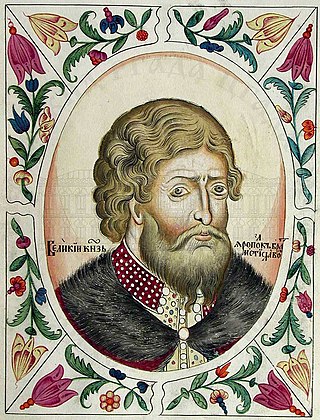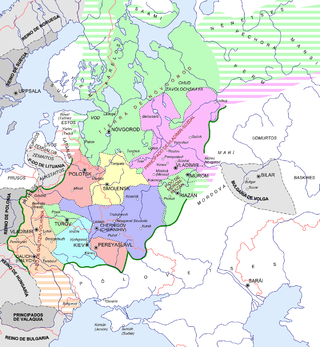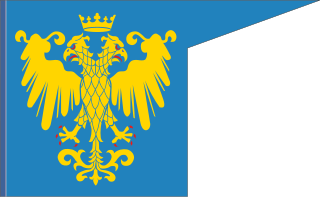Rostislavich (Ростиславич) or Rostislavovich (Ростиславович) is a Russian patronymic name. It may refer to one of the following persons.

Yaropolk II Vladimirovich was Prince of Pereyaslavl (1114–1132) and Grand Prince of Kiev (1132–1139). He was a son of Vladimir II Monomakh and Gytha of Wessex. He fought in several campaigns against the Cumans, once in 1103 and again in 1116.
Rostislav Mstislavich was Prince of Smolensk (1125–1160), Novgorod (1154) and Grand Prince of Kiev. He is the founder of the Rostislavichi branch of Rurikid princes in Smolensk. He was the son of Mstislav I of Kiev and Christina Ingesdotter of Sweden.
Ingvar Yaroslavich was Prince of Dorogobuzh, Prince of Lutsk (1180–1220), Grand Prince of Kiev, and Prince of Vladimir-Volynsk (1207). He was son of Yaroslav Izyaslavich, great-grandson of Vladimir II Monomakh.

The inner Principality of Kiev was a medieval principality centered on the city of Kiev.
Mstislav Rostislavich, known as "the Brave", was Prince of Smolensk and Prince of Novgorod.
The Prince of Chernigov was the kniaz, the ruler or sub-ruler, of the Rus' Principality of Chernigov, a lordship which lasted four centuries straddling what are now parts of Ukraine, Belarus and the Russian Federation.
The Prince of Pereyaslavl was the ruler of the Principality of Pereyaslavl, a lordship based on the city of Pereyaslavl on the Trubizh River, and straddling extensive territory to the east in what are now parts of Ukraine. It was situated on the southern frontier of Kievan Rus' and bordered the steppe.

The Principality of Smolensk was a Kievan Rus' lordship from the 11th to the 16th century. Until 1127, when it passed to Rostislav Mstislavich, the principality was part of the land of Kiev. The principality gradually came under Lithuanian influence and was incorporated into the Grand Duchy of Lithuania in 1404. The principality was reorganized into the Smolensk Voivodeship in 1508. The Principality of Moscow controlled the city from 1514 to 1611, then it was recaptured by the Polish–Lithuanian Commonwealth. Tsardom of Russia recaptured the city in 1654.
The Prince of Murom was the title of the ruler of the Principality of Murom.

The Principality of Murom, also referred to as the Murom-Ryazan Principality until the mid-12th century, was a principality with its capital in Murom, now in Vladimir Oblast, Russia. Murom lay in an area that was strongly Finnic and for much of its medieval history, located in the homeland of the Muromians. In 1392, it was incorporated into the Grand Principality of Moscow.

The Principality of Peremyshl was a medieval petty principality centred on Peremyshl in the Cherven lands.
Yaroslav II Vsevolodovich was an Olgovichi prince. He was prince of Ropesk, of Starodub (1166–1176), and of Chernigov (1176–1198).
Rostislav Yaroslavich was a Rus' prince. His baptismal name was Ivan. He was prince of Snovsk.

The Principality of Turov, later called the Principality of Turov and Pinsk, also known as Turovian Rus', was a medieval principality of Kievan Rus' from the 10th century on the territory of modern-day Belarus and northern Ukraine. The princes of Turov often served as grand princes early in 10th and 11th centuries. Its capital was Turov (Turaŭ), and other important cities included Pinsk, Mazyr, Slutsk, Lutsk, Brest, and Volodymyr.
The Principality of Vitebsk was a Ruthenian principality centered on the city of Vitebsk in modern Belarus, that existed from its founding in 1101 until it was nominally inherited into the Grand Duchy of Lithuania in 1320. Vitebsk would later fall under the complete authority of Lithuania in 1508.

The sack of Kiev took place on 8–12 March 1169 when a coalition of 11 princes, assembled by prince Andrey Bogolyubsky of Vladimir-Suzdal, attacked the Kievan Rus' capital city of Kiev during the 1167–1169 Kievan succession crisis. The conflict, caused by the death of grand prince Rostislav I of Kiev, was between rival branches of the Monomakhovichi clan: the Iziaslavichi of Volhynia on the one hand, and the Rostislavichi of Smolensk, the Yurievichi, and the Olgovichi of Chernigov on the other. Prince Mstislav II of Kiev sought to defend Kiev against the Rostislavichi–Yurievichi–Olgovichi coalition.

The battle and siege of Vyshgorod took place in late 1173, during the 1171–1173 Kievan succession crisis. Commanding another broad coalition army, prince Andrey Bogolyubsky of Vladimir-Suzdal launched a second campaign against Kiev, capital city of Kievan Rus'. After the conquest and sack of Kiev in March 1169 by an earlier coalition assembled by Andrey, his brother Gleb of Pereyaslavl had been installed as the new grand prince, only to die under suspicious circumstances in January 1171. A series of princes briefly reigned in Kiev thereafter, with Andrey usually managing to put his preferred candidates on its throne, until his brother Vsevolod "the Big Nest" was driven out by the Rostislavichi of Smolensk in April 1172, enthroning Rurik Rostislavich. Andrey was most displeased when he heard about this, and assembled another coalition army under his son Yury to militarily enforce his will on Kiev.







